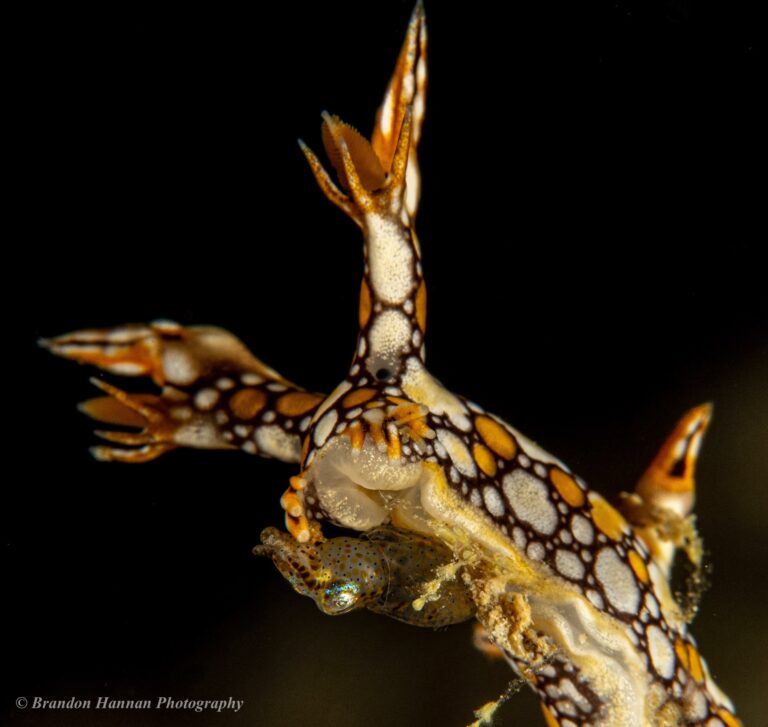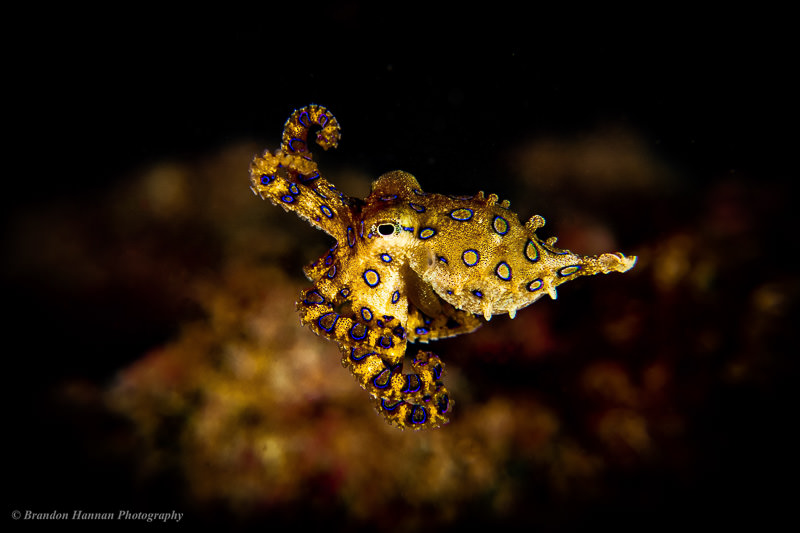
Editor’s note: The Sony RX100 V is a very popular compact camera for underwater photography, with excellent performance and image quality packed into a small camera body. Brandon’s amazing photos below really attest to this. If you are interested in learning more about this camera, check out our detailed RX100V/VA camera review.
My wife and I moved to Okinawa, Japan in late 2017. The waters here in Okinawa are absolutely stunning. Easy access to diving in such a remarkable place is exhilarating. However, it wasn’t until I met Rob Kidston (an underwater photographer) that my love for photography began. I purchased my Sony RX100V, Nauticam housing, and my Sea & Sea YS-D2 strobes from www.bluewaterphotostore.com, and jumped right in.
My love for cephalopods is undeniably strong, after spending many nights watching National Geographic and Discovery Channel. I was fascinated with how many species of cephalopods there are and just how unbelievably intelligent they are.

First encounter with a Hapalochlaena Lunulata “Blue-Ringed Octopus”
My first encounter with the venomous blue-ringed octopus was one to remember. My dive buddy found one sitting on a beautiful soft coral. You can imagine the excitement of finally spotting one of these amazing cephalopods. We watched him for about twenty minutes moving around on the reef. I was watching my dive partner take pictures when the blue-ring decided he had enough of photos. The octopus left the reef and came straight at me. You can imagine the sheer panic. I didn’t see where he went, so I thought he was on me. We surfaced, and I stripped my gear but didn’t find him; needless to say I ended the dive due to the adrenaline and anxiety.
As it turns out, they are not aggressive unless provoked or cornered. You just have to allow them space and view them from a distance, and you won’t have any issues. Even though my first encounter wasn’t what I wanted it to be, my love and respect for this octopus has only grown with each of my future encounters.
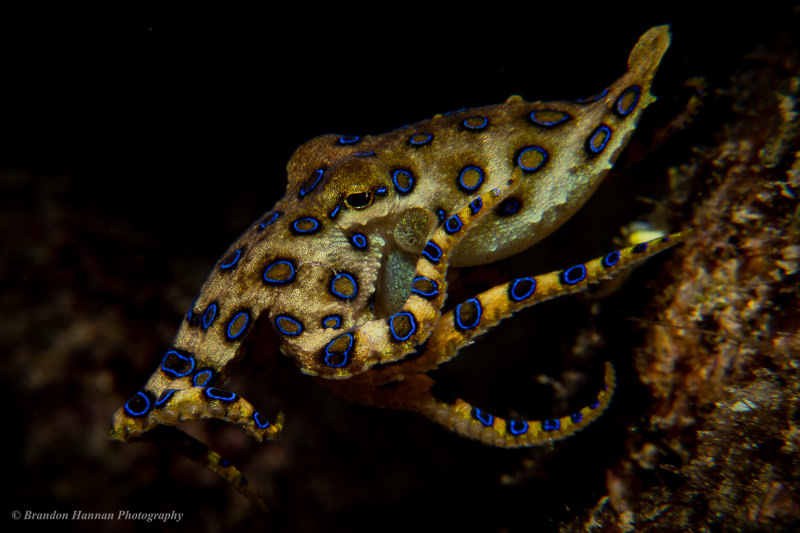
We normally spot these octopi once every few night dives. The Indo-Pacific species is quite a bit smaller than its Australian relative. They can range in size from ½ in to 3 in, and are not as shy as most species of octopus, probably because they carry enough venom to kill 26 adult humans. They move around hunting for small prey or crustaceans, and will not show their bright blue rings unless they feel something is too close or if they feel threatened. For me the highlight of shooting this species was getting a fully extended open water shot of one. I challenge myself to wait for the perfect timing, rather than just being happy with getting decent photos of the subject sitting on the reef. For this octopus I shot 1/250, f/11, ISO 100. I use a +7 macro wet lens that screws right on the front on my housing.
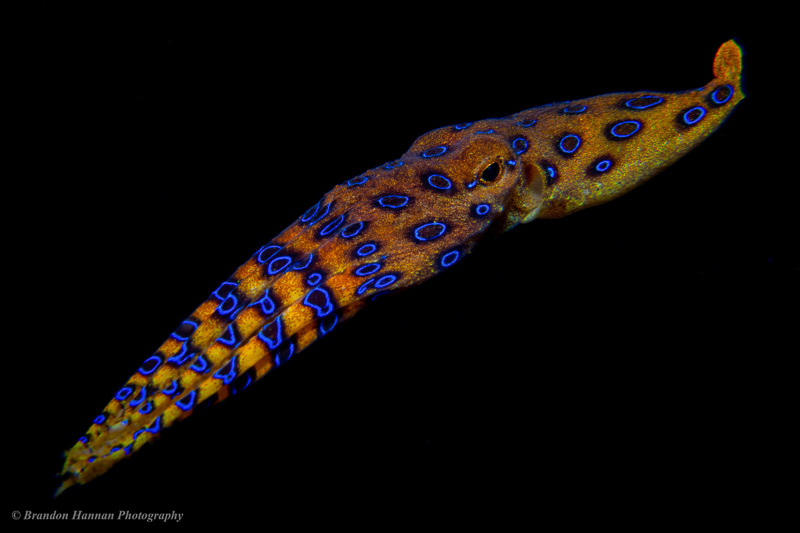
The Beautiful Metasepia Tullbergi “Flamboyant Cuttlefish”
Off the coast of Okinawa, an incredible cuttlefish can be found. The Paintpot Cuttlefish, better known as the Flamboyant Cuttlefish, are slightly smaller than their close relatives in the Philippines, the Matasepia Pfefferi. These cephalopods can be tough to spot if you don’t know what you are looking for, and are mostly found in depths of 25ft-70ft of water. They can be all white and camouflaged to look like the rocks surrounding them, or, depending on the threat level, they can range in colors from white, purple, yellow, and black, to the famous flamboyant radiating color scheme that everyone loves. This color scheme lets all the other predators in the ocean know that they are poisonous.
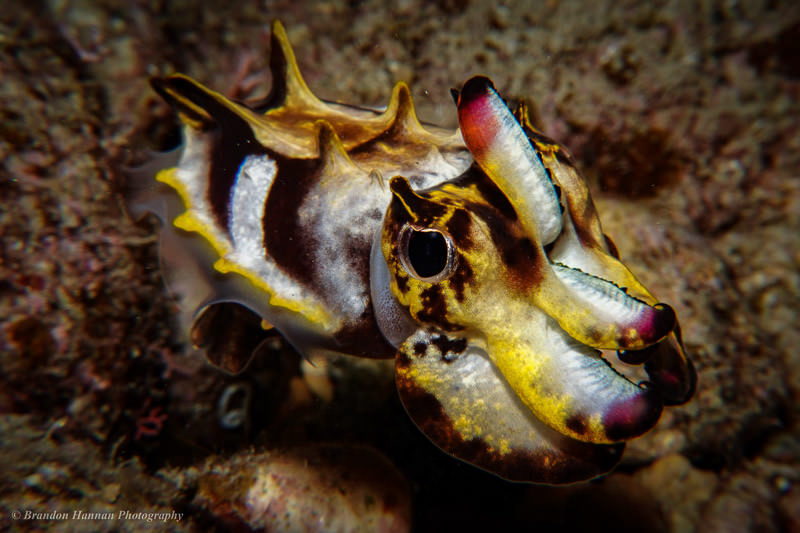
I have spent night after night diving to see these spectacular cuttlefish. We dove multiple spots along the coast of Okinawa searching for flamboyant habitats, and found certain rocky locations had rich populations. Watching cuttlefish in their natural habitats can be so rewarding. The way they move around the bottom of the ocean is quite unique, as they mostly walk wherever they go. This unique trait of walking, and not swimming, can only be found in a few of the cuttlefish species.
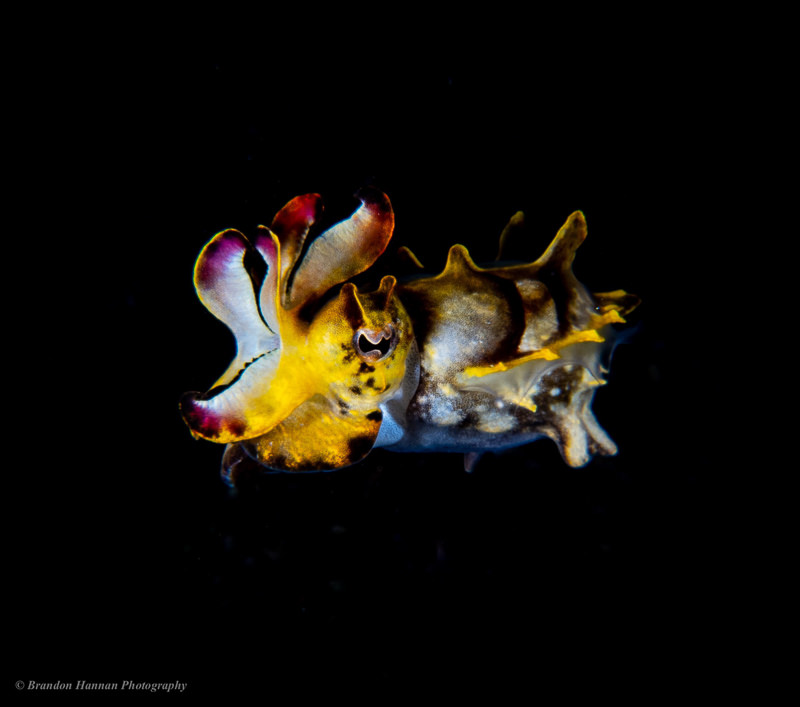
The Spotty Bobtail Squid, Sepiola parva
The spotty bobtail squid really puts on a show. Did you know that bobtail squids actually belong to their own group, separate from cuttlefish and squids? This species is one of only a handful that uses a light organ, which is located near the stomach. Spotty bobtail squid collect bioluminescent bacteria from the water, and store them in their light organs. They use the light produced by the bacteria for counter-illumination when they are swimming at night, and then each morning they return to the sandy bottom to completely expel and renew their bacteria.
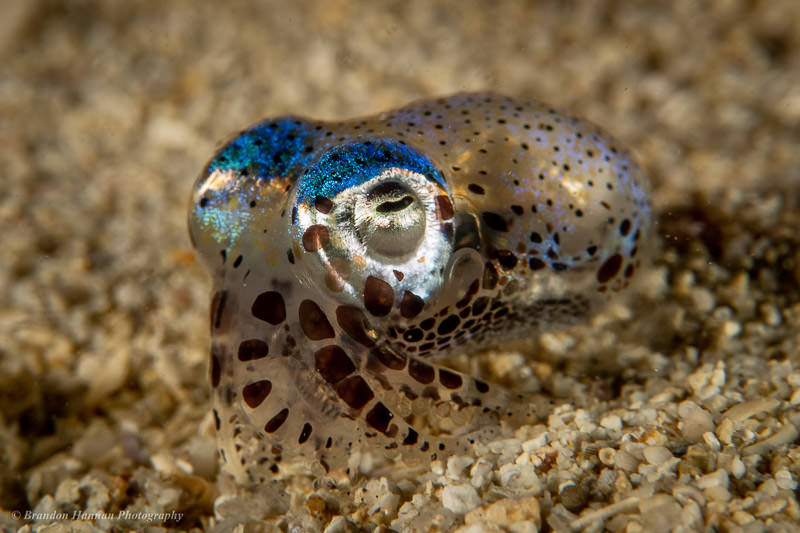
Spotting bobtails in the water can sometimes be quite tricky. Usually they are found at night on the sides of reef, by a sandy bottom. When looking for this species you will see little squid shaped ink spots, known as pseudo-morphs, in clusters of three. Bobtails use these to try to fool any potential predators from spotting them as they make their getaway. After being spooked, they immediately head toward the reef for an opening, or to the sand. Once in the sand they bury themselves with only their eyes and top of their body exposed. Photos of this bobtail are unique, with each individual displaying different rainbow colors produced by its iridiophores.
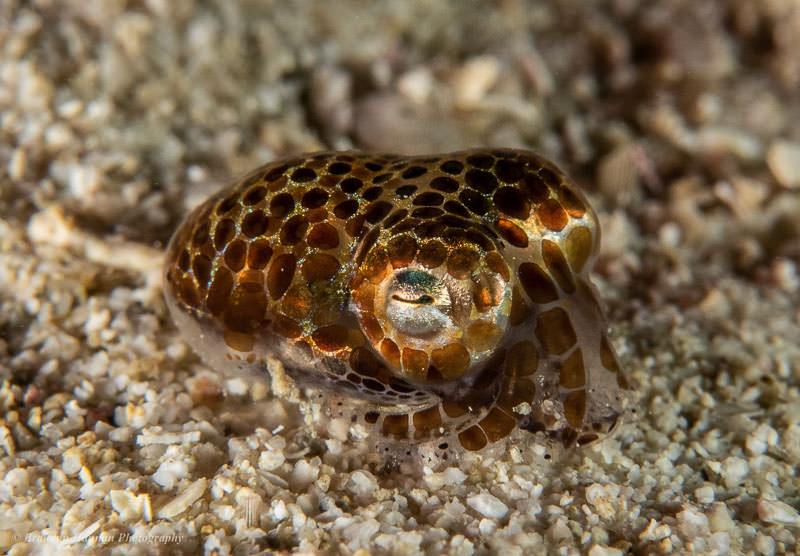
There are a few different species of bobtail here in Okinawa, Sepiola parva being the most common one “spotted”. I recently had a rare encounter with the tropical bobtail squid, Sepiadarium kochi. This bobtail has distinct orange skin, white around its eyes and tiny blue-ish white circles on its body. This species is a real treat to observe, and unlike Sepiola parva this species buries itself much faster, is very shy, and doesn’t have a light organ.
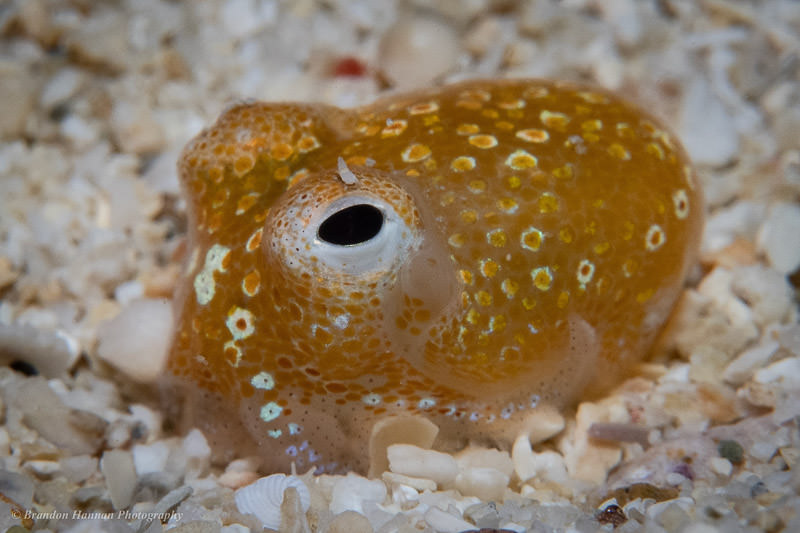
The Mysterious Undescribed Pygmy Squid
Diving can be full of surprises; you never know what you might find! One night off the east coast of Okinawa, we were diving when I spotted a small pygmy squid. The squid was about 3mm in length, or the size of a grain of rice. It was incredibly hard to get a good close-up photo with my Subsee +10 wet lens. However, I did manage to get a few shots, before moving on.
I posted some of the shots on our local Facebook page, and quickly received a message from Jeff Jolly, a marine biologist at the Okinawa Institute of Science and Technology. This species is an undescribed pygmy squid and they had been searching for them to study their biology and describe the species. He had collected some in the past and sequenced their DNA. When the DNA was compared to existing samples of all squids in DNA database, it was found to not match any others that have been described.
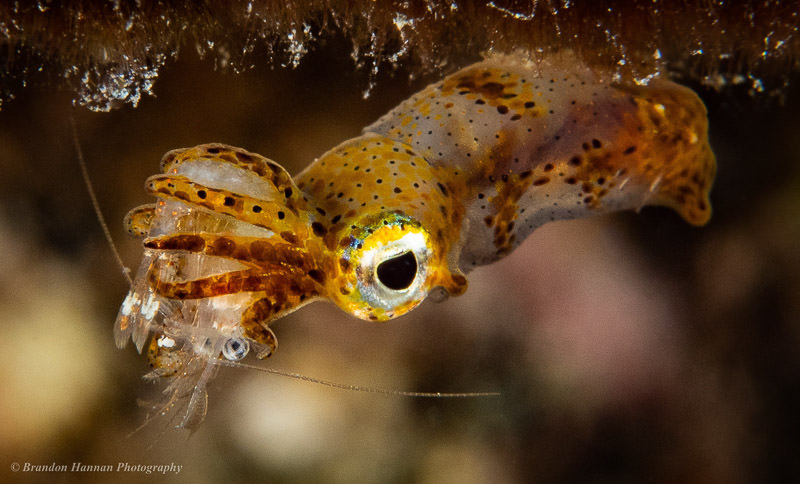
Over the next few months, we dove and searched for more of these squid. Eventually I located two and collected the specimens to be studied. The specimens laid many eggs in the lab while being isolated. What does this tell us about the females? Even though the female was separated from the males, it stored sperm and fertilized the eggs when it deposited them. After collecting a few more of these and taking lots of photos, there were a few features that were obviously unique to this species. Under each eye they would display a ridge that comes to a point. Obviously it is not yet known why they display this because it’s not always present. Some other interesting characteristics include several white dots near their fins and a sticky part of their skin they can use to attach to rocks, coral, and sea grass. Although it will take some time to study this species and describe it, I am excited to see what the name will be. We have nicknamed this species Hannan’s pygmy squid!
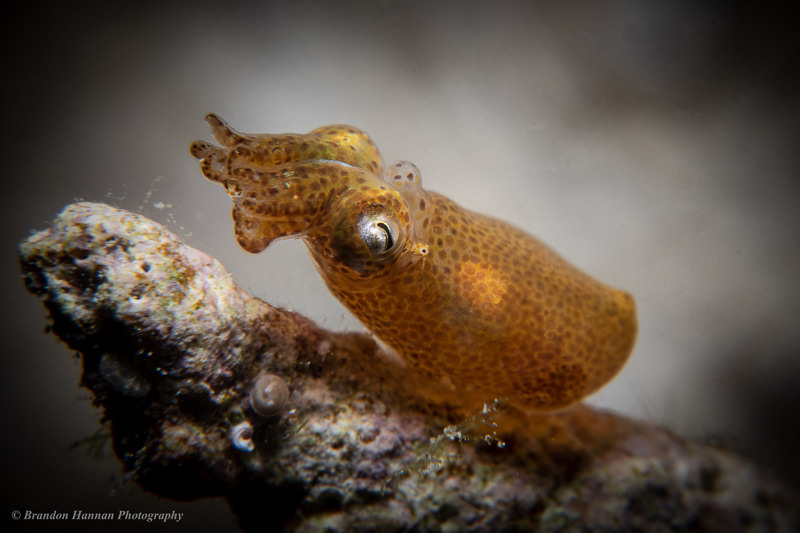
The Octopus Joubini “Wolf Pygmy”
These amazing octopi can be found in shallow reefs around Okinawa. They like to stay hidden behind corals and are mostly spotted at night, reaching up to 2 inches in size. The first one I ever found was on a night dive on the west side of Okinawa. When I spotted the Pygmy he was in the sand and very frightened of me. I was perplexed as to what kind of octopus this was. He was so small and it wasn’t the season for juvenile day octopus to have hatched. Researching on the internet and looking at my photos I figured out that it was in fact the Wolf Pygmy octopus.
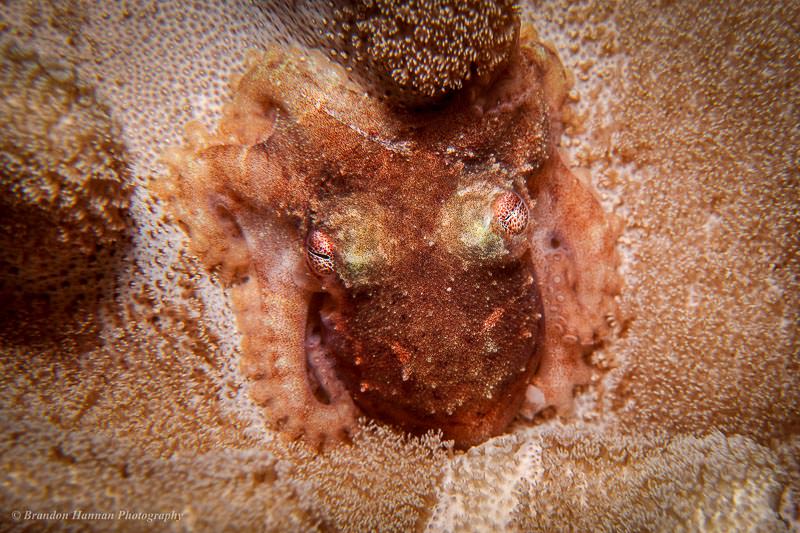
This octopus has a very distinct color pattern, showing either all white or sometimes reds with hues of blue. The octopus’s eyes are different from other species, as they have red eyes even when they change colors. When you spot any cephalopod you want to have a red light at night. It allows them to become more relaxed and comfortable with you around. It’s good to be patient and let them move for a while. Once they become used to you, then you can get some really beautiful photos. Sometimes they have a pattern on them that I like to call a “starburst” or “galaxy” pattern.
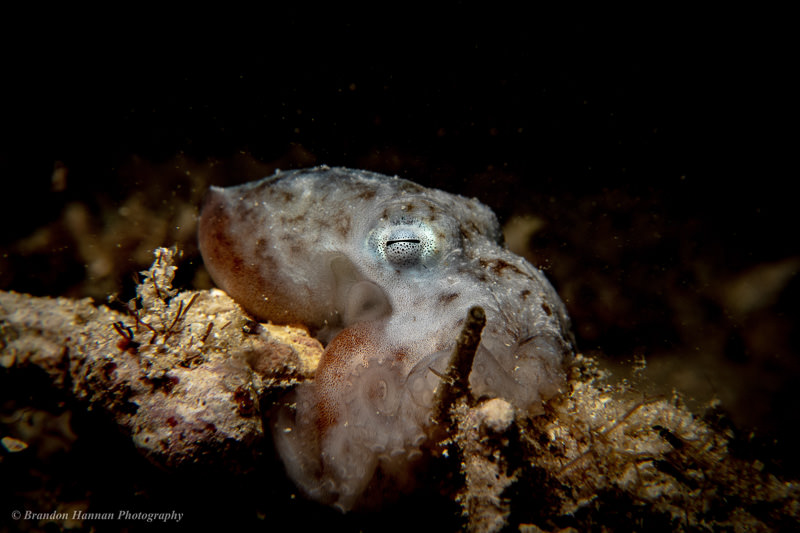
The Sepioteuthis Lessoniana “Bigfin Reef Squid”
The bigfin reef squid can be found from depths of 10ft down to 100ft. Squid are usually found in groups of three or more. In my experience squid are the only cephalopods species that will stay around if you use white light. In fact, the first time I spotted squid I immediately switched over to red light, and they quickly disappeared. After a few tries I noticed if I left my bright white lights on it would actually confuse the squid, making them stay in the area and not bolt to the surface. When shooting this species you have to be aware of your surroundings and depth, especially if you are over a deep reef. It’s better if you have an experienced partner watching your depth while you take photos and then vice versa. I love to get photographs of this squid, the black backgrounds with the florescent colors make for wonderful images.
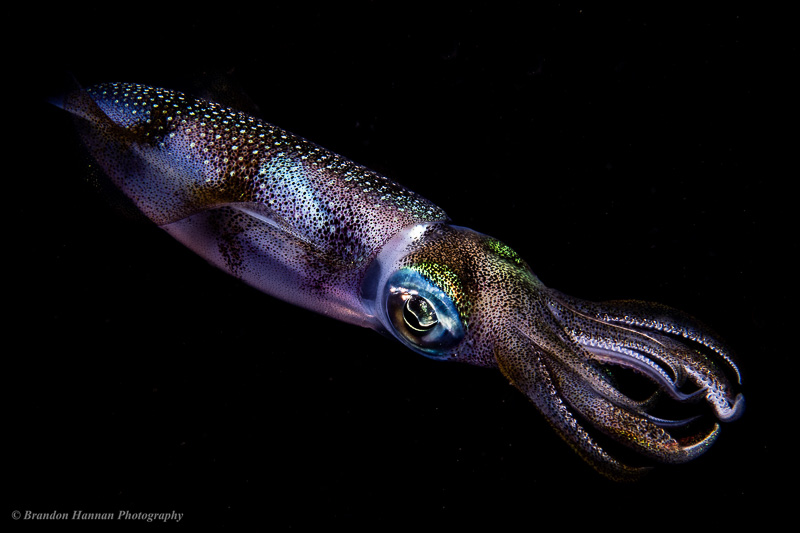
Lighting and conditions affect cephalopod photography. When I photograph these on my Sony RX100 V compact I keep my F-stop in the middle around 6.8 and put my shutter speed at 1/250. How I take my photos also depends on the size of the squid. Sometimes I will leave my settings at 1/250, F11, and ISO 100, keeping my YS-D2 strobes in TTL and moving them as far out as my rig will allow. Squid do not stay around long, leaving your camera in TTL and moving the strobes out eliminates backscatter, and lighting will never be over exposed. The adjustments made to the strobes while underwater can be the difference of a good shot before the squid leaves and an overexposed/underexposed shot.
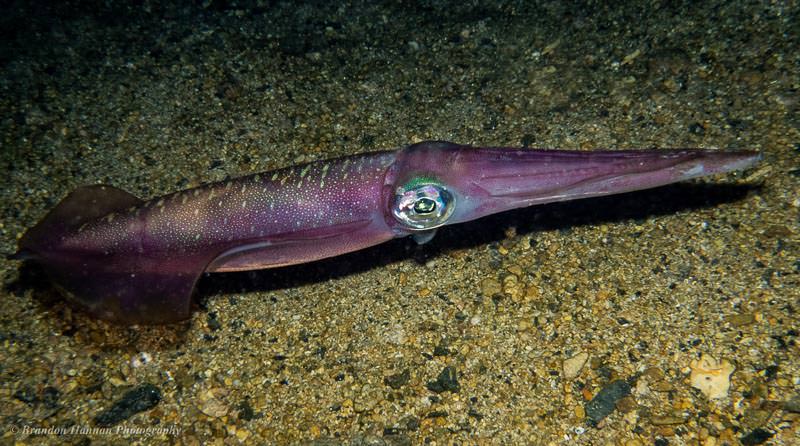
The Octopus Macropus “Spotted Octopus”
The spotted octopus is one species I don’t see too often. This octopus can be found in depths up to around 60ft and prefers grassy areas or coral rubble and sand. The first one I found I was very excited. The octopus had white spots on it, which never changed color even when the octopus did. It was fascinating to see such a peculiar looking octopus.
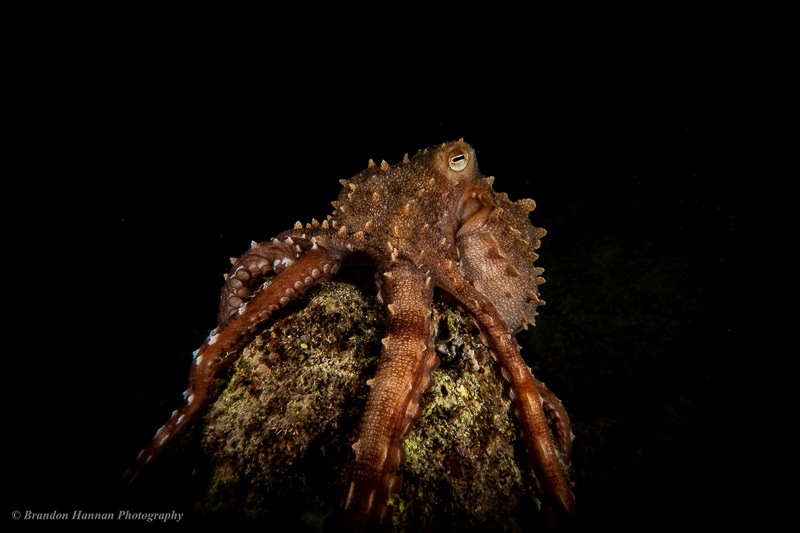
They are shy at first but after spending some time with them, they become relaxed and inquisitive about you. They often want to come near you and touch your camera or your hand. They will continue to hunt and move while you are photographing them, almost like they want to pose for you.
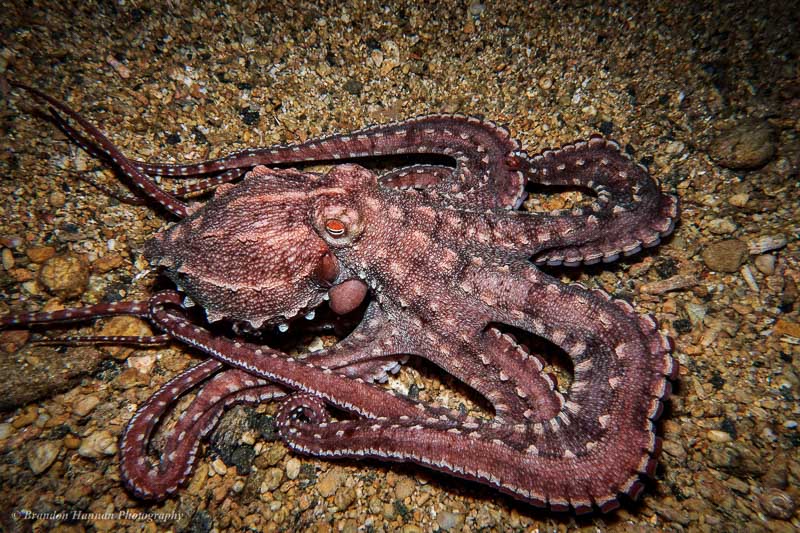
The Octopus Cyanea “Day Octopus”
This is the most common octopus to see here in Okinawa. Spotting this species is quite easy. It is often found at depths between 10ft to 100ft on the rocky sides of reefs. It can flash different colors with a variety of skin textures, to mimic the reef. Often the Day Octopus will hide in the nearest hole or cave until it deems you as non-threating. When scared the octopus will turn to a pale white to gray color, sometimes shooting a burst of ink trying to get away.
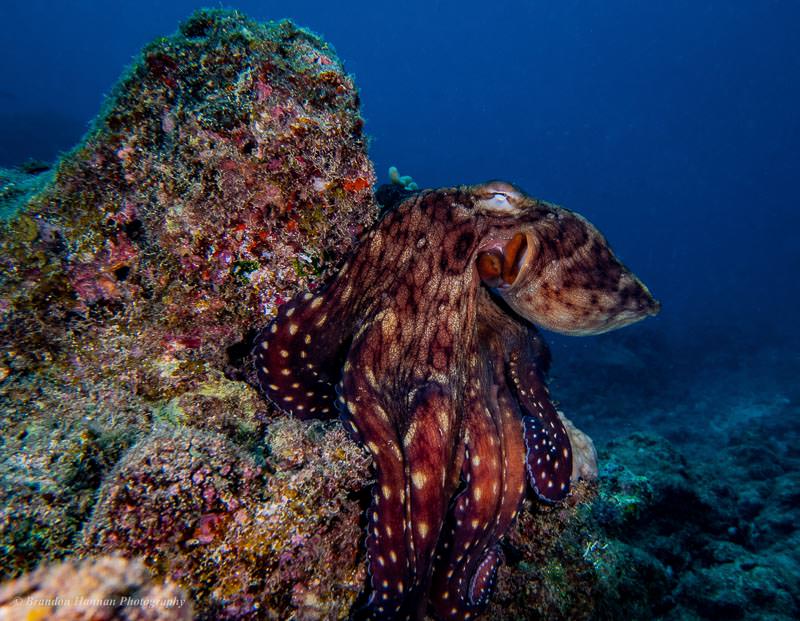
The day octopus will hunt mostly around dusk or even early morning. Octopus hunt by sticking their tentacles into rock crevices and expanding their bodies around the reef like a cape to trap escaping prey. Once caught, the octopus bites the prey and injects a toxin to subdue it. Often times you will find the octopus with a coral grouper – the behavior is unique. The grouper waits while the octopus hunts, and gets itself an easy meal by catching any potential prey that escapes from the octopus.
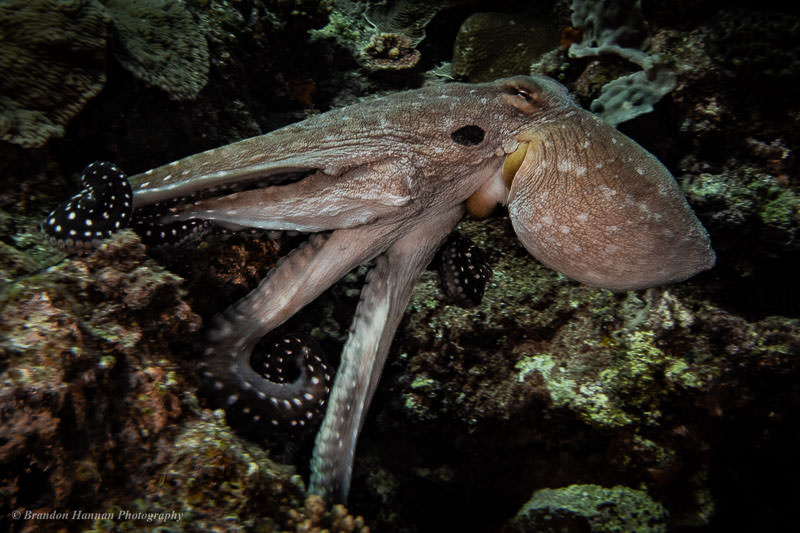
Tips for Shooting Macro with the RX100V
Here are some of my top tips for shooting macro with the RX100V.
- Don’t over-think the shot. Get to know the camera that you have and practice what’s comfortable for you. Everyone’s setup and settings won’t be the same.
- When shooting something with a wet lens, you want to zoom in as much as possible on the subject. The lens will give you a closer image. I would suggest using aperture F11 and moving your shutter speed to about 1/250.
- Having a focus light is key when shooting at night. I use the Sola red light for all my macro shooting, with it mounted on one side of my setup. Some photographers prefer it in the middle on the hot shoe.
Tips for Finding and Photographing Cephalopods
Knowing how to find cephalopods and interacting with them properly really helps maximize your photo opportunities. Here are some of the top things I have learned from spending so much time with these fascinating creatures:
- Be patient and take your time when searching the reefs. Cephalopods are incredibly smart. If they don’t want you to see them, you will not. Octopus will mostly be found close to the reef edge, and on rocky substrates with crustaceans.
- After finding them, relax and let them become used to you. If you find them at night, remember red light is key to them staying around. The only cephalopod that red light does not work on in my experience is the squid, use white light for them when spotting them at night.
- When hunting for flamboyant cuttlefish it’s best to look in rocky areas. They are masters of camouflage and will often look like rocks until approached. They are very difficult to spot. Once spotted and relaxed they will continue to hunt and move about while you watch.
- Enjoy these fantastic species, but the biggest tip of all: respect the cephalopods and their space. Do not touch them. Most octopus have some sort venom, and even if it isn’t toxic to humans, they have very strong beaks and can cause severe pain if bitten.
Gear Links
- Sony RX100V Camera
- Nauticam RX100V housing
- Bluewater +7 Macro lens
- Inon Ucl-67
- Subsee + 10 wet macro lens (diopter)
- Sea & Sea YS-D2J strobes
Additional Reading
- Sony RX100V/VA Camera Review
- Sony RX100VI Camera Review
- Pushing the Limits of Macro with a Compact Camera
The Sony RX100 V and VA is available now at Bluewater Photo!









